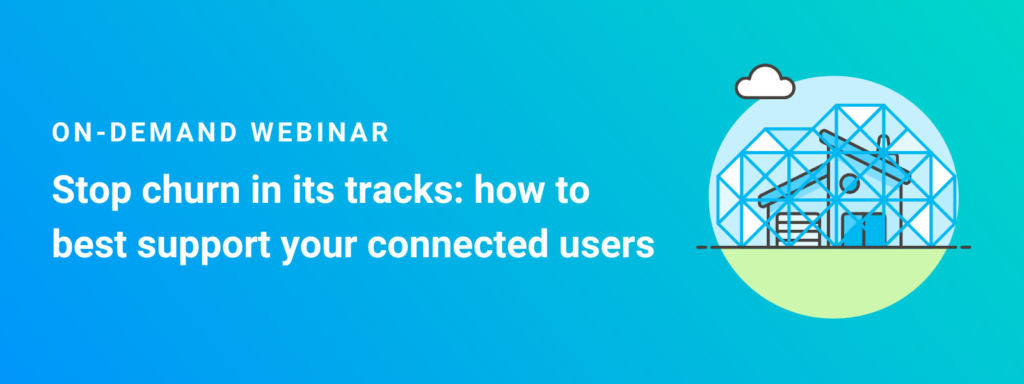As a broadband provider, you’re looking for opportunities to increase revenue streams that have a low barrier to entry. You recognize that the rise of smart homes creates both new opportunities and challenges for your company, especially when it comes to broadband service architectures.
With rapid advancements in service containerization, you might be wondering what the ideal architectures are to enable a dynamic service platform that keeps you one step ahead of the competition.
Recently, Ozmo presented at the vBASe webinar hosted by Broadband Forum titled, “Connected User – Is a Service Provider ‘App Store’ deliverable?” to answer your questions on how smart devices are accelerating industry change and what you can do to prepare.
The webinar included an in-depth discussion of the best approach for providers from cloud-based to intelligent CPE based solutions when it comes to service containers. Below, we go over how smart homes are reshaping broadband service architectures and how your business can stand out from the competition.
About the virtual event
The panel webinar covered how smart homes are sparking rapid evolution in the broadband industry and how the rise of service containers can unlock new revenue streams. Additionally, these models have the power to completely revolutionize service offerings, potentially shifting broadband providers from bundles to an “app store” model.
However, service containerization also poses potential challenges for companies. To help companies better prepare for such radical shifts, the webinar’s presenters discussed in depth the impact of service containerization, potential broadband service architectures, best use cases and how to support your connected users.
The Broadband Forum is the industry’s leading organization focused on fostering broadband innovation, developing industry standards and creating a thriving broadband ecosystem. The webinar featured speakers from various broadband companies, such as F-Secure, CommScope, KAON Broadband, as well as Ozmo’s Co-Founder and Chief Growth Officer, Aaron Herrington.
Want to learn more about the deliverability of service provider "app stores"?
The broadband industry is getting smarter
The demand for broadband skyrocketed during the height of the pandemic in 2020. In fact, over 85% of U.S. households have broadband internet. However, the rise of smart homes is transforming customer wants and needs. Below are a few ways smart devices are changing the smart home industry.
More customers are using smart devices
Your customers’ homes are becoming increasingly smarter. They ask Alexa to tell them the weather or to create their grocery list. They program their smart vacuum to clean up every afternoon. Their fridge sends them notifications when they’re out of milk.
Smart devices are becoming an integral part of your customers’ everyday lives. It’s estimated that over 57% of U.S. households will have a smart device by 2025. Broadband companies need to take this into account when planning long-term business strategies.
Smart home devices provide new opportunities for broadband companies
The smart home market is expected to be worth more than $537 billion by 2030. The increased adoption of smart devices presents new revenue opportunities for broadband companies. For example, broadband companies can offer smart home devices as add ons to broadband plans. It also allows broadband businesses to innovate and bring new services to market at a much faster rate.
Smart devices are creating challenges for broadband providers
While smart devices provide exciting opportunities for innovation and revenue, the rise of the smart home also creates challenges for broadband companies.
The rapid adoption of smart devices has drastically shifted customer expectations of broadband providers and tech support. Combined with increased network congestion, many businesses are battling customer churn in a market with tough competition. Businesses must prepare to address these challenges to stand out from competitors.
The future of broadband: service providers as an app store
More customers want more flexibility. When they’re shopping for a broadband provider, they’re moving away from traditional bundles. Instead, they’re gravitating towards a la carte broadband service architectures.
A la carte services allow customers the freedom of only purchasing what services they want, versus traditional rigid bundles that may include features they don’t want or need.
This is where service containerization could potentially help broadband companies stay one step ahead of the competition. Traditionally, service offerings have been limited to those of the Customer Premise(s) Equipment (CPE) vendor. However, with service containerization, broadband providers can easily deploy third-party software, enabling the rapid expansion of service offerings for subscribers and new revenue opportunities for companies.
How broadband providers can prepare for this shift
The rise of the smart home is drastically changing the broadband industry. Companies must respond quickly to meet consumer demands and stand out in a fiercely competitive market. Below are a few tips to help your business prepare for this shift.
Create a seamless onboarding experience
74% of people will switch providers after just one bad customer service experience. Therefore, it’s critical to ensure your customer onboarding process is as smooth as possible.
To effectively onboard your customers, make sure to provide access to new device workflows, empower customers with self-service and keep all onboarding materials up-to-date. Doing so will help your company lower customer churn, reduce truck rolls and increase brand loyalty.
Help customers get the most out of their smart device
After you’ve successfully onboarded customers, help them get the most out of their smart devices. Educate them on various features and functionality that they may not know about.
For example, while many customers may know to ask Alexa about the weather, they may not know that they can use Alexa Guard, a feature that uses speakers to detect suspicious activity inside their house.
This also provides an opportunity for you to showcase the interconnectivity between all your unique services and offerings. While customers aren’t necessarily looking for bundled services, they are more likely to purchase multiple services from the same provider if they have a positive experience with the company.
Help customers keep smart devices secure
As more of your customers adopt smart technology, help them to keep their devices secure. According to the University of North Georgia, a hacking attack occurs every 39 seconds.
Therefore, it’s vital to teach customers how to keep their smart home technology safe and secure so they can continue to have an optimal experience. For example, encourage them to adopt security best practices such as creating unique passwords for each smart device and enabling two-factor authentication.
Provide full life-cycle support
Be sure to provide customers with the customer support they need at every stage of their journey, from pre-buy to post-sale. To do this successfully, it’s vital to create a consistent customer support experience across all services, including internet, security and smart home support. Additionally, when creating your customer support strategy, always keep the buyer’s journey front-of-mind.
Equip agents with the tools they need to provide effective tech support
Focusing on ways to provide better smart home support is vital for your company to stay competitive in the increasingly crowded broadband market. 89% of customers will leave your business due to poor customer service.
To avoid this, ensure that you provide your contact center agents with the tools they need to provide accurate and timely customer service. For example, a library of physical devices for your agents is expensive to maintain and quickly becomes outdated.
A more cost-effective and efficient solution is virtualization. Virtualized tech support allows agents to simulate the functionality of physical devices. However, unlike physical devices, they can switch between different versions and software updates. This helps agents provide more tailored and accurate support, which increases first-call resolution rates and improves net promoter score (NPS).
Offer customers self-service support options
It’s not enough to provide customer support. You also need to provide service in the customer’s preferred format. More customers are turning to self-service options before reaching out to a contact center agent. In fact, 89% of customers expect companies to provide self-service options.
But the key isn’t just to do self-service, but to do it effectively. Some general customer self-service best practices include:
- Make it easy for customers to find the information they need.
- Make customer self-serve tutorials accessible (WCAG compliant).
- Regularly update your content.
- Provide tutorials in multiple formats.
Smart homes are accelerating the evolution of broadband service architectures
The broadband industry is constantly evolving. However, the adoption of smart devices among customers has rapidly propelled service containerization into the spotlight, which has significant implications for the future of the broadband industry.
The rise of service containerization has the power to shift broadband companies from bundled services to an a la carte “app store.” To prepare, broadband providers must keep the customer experience front-of-mind, focusing on helping customers get the most out of their devices, providing full life-cycle support and equipping contact center agents with the right tools.

Are you looking for ways to provide customer support that helps you stand out from the competition. As a leader in omnichannel customer support, Ozmo is trusted by companies like Verizon, TELUS and more. Learn more about the future of tech support today!



